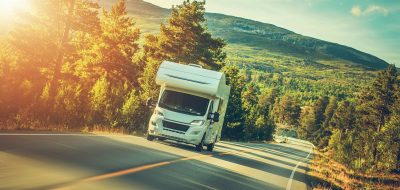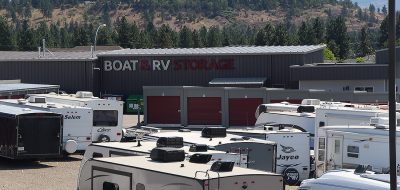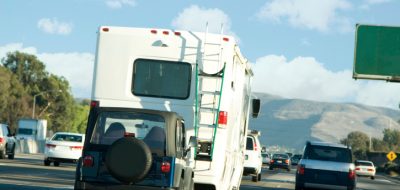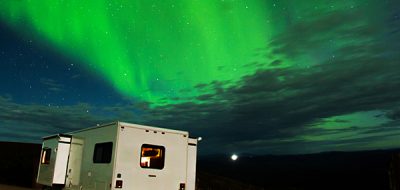 A Thought from Lug_Nut. First introduced by Chrysler in 1958, Autocruise, or cruise control, was a primitive device to automatically maintain a given travel speed. It basically was a vacuum controlled linkage that was connected to the throttle valve on the carburetor. If the vehicle speed dropped below that of the set speed, the linkage would simply pull the throttle valve until the desired speed was accomplished.
A Thought from Lug_Nut. First introduced by Chrysler in 1958, Autocruise, or cruise control, was a primitive device to automatically maintain a given travel speed. It basically was a vacuum controlled linkage that was connected to the throttle valve on the carburetor. If the vehicle speed dropped below that of the set speed, the linkage would simply pull the throttle valve until the desired speed was accomplished.
Over the years, and with the coming of the electronic controlled engines, the cruise control advanced rapidly in newer technology. Now the cruise control is a highly developed micro processor controlled device commanded by the onboard ECM (Electronic Control Module). It is now capable of being programmed to manage the fuel delivery in a manner most efficient for fuel consumption while still maintaining a given desired vehicle speed.
Earlier cruise controls tended to operate in an “all or nothing” fashion when the vehicle was confronted with a rolling series of slight grades and descents at highway speeds. But, unlike these older designs, the newer controllers have a preprogrammed buffer that prevents the knee jerk reaction experienced prior. This buffer is in the form of a preset speed tolerance called “The Droop Settings”. The droop settings are calibrated to allow the vehicle to fall or gain a given amount from the set speed with very little or no reaction. Therefore short rises may require very little or no throttle. Additionally, they also have the ability to apply proportionate power when needed.
 The fact that cruise control modules are now micro processor controlled gives them the ability to share communication with other devices. Radar, for example, such as Eaton’s Vorad, TRW or Delphi can communicate with the cruise device and offer what is termed as “Active Cruise Control”. With this setup, radar sensors located in the front bumper, guard for traffic travelling ahead. If a vehicle appears within a set range, the Vorad communicates to the cruise control module and the controller automatically reduces speed to match that of the car ahead. This feature can be found on many higher priced cars and has been available on some motor coaches.
The fact that cruise control modules are now micro processor controlled gives them the ability to share communication with other devices. Radar, for example, such as Eaton’s Vorad, TRW or Delphi can communicate with the cruise device and offer what is termed as “Active Cruise Control”. With this setup, radar sensors located in the front bumper, guard for traffic travelling ahead. If a vehicle appears within a set range, the Vorad communicates to the cruise control module and the controller automatically reduces speed to match that of the car ahead. This feature can be found on many higher priced cars and has been available on some motor coaches.
Cruise control modules generally come with the parameters preprogrammed by the vehicle maker. These defaults fit most applications. In the case of motor coaches, and in particular, diesel pushers, other features may be enabled. The following are examples of additional features that may already be programmed or possibly can be.
- Increased warm up neutral idle control (Depressing the “Resume” or “Set” button selects and adjusts a higher idle while in neutral)
- Last speed memory (Remembers the last set speed even after being shutdown and restarted
- Automatic compression brake activation management (Shifts down at 6 MPH over speed and applies Jake at about 8 MPH over speed if the compression brake is on)
- Automatically disengage the Jake brake and select up shift (Both the engagement and disengagement of the compression braking system is done with extreme smoothness
- Fuel flow stopped (During the employment of the Jake brake fuel, to the injectors is turned off)
- One push per one mile per hour (Once cruise is engaged, one push equals one mile per hour, set reduces, resume increases)
If some of these features are not currently available on your cruise control, they can usually be programmed by your engine service provider or you may be able to get the cables and software to do it yourself with a laptop.
So, now to the question, can a modern cruise control manage the throttle more fuel efficiently than the operator?
Providing the cruise control module is programmed optimally for the specific vehicle, I believe there is no question. This, of course, may be subject to a few exceptions including the possibility of a highly skilled operator under certain circumstances.
So, what’s your take? Do you use your cruise control to help reduce fuel consumption?
Keeping You Cruising – Lug_Nut – Peter Mercer






George
Specifically referencing Phil’s and Don’s comment, I run a 2003 Ford F350 CrewCab, DRW, 7.3L, automatic tranny. Last January I had Banks Power install the “Six Gun” Package and this increased my fuel mileage from 12.6 to 13.9 mpg. I run at 23,200 lbs with my 37 foot 5th wheel and at 55-62 mph makes no difference for fuel consumption. At 62 mph I’m at 2150- rpm. I prefer to run with the cruise but if going down a hill, and I see an uphill grade ahead of me, I will “help” the cruise by increasing throttle and picking up a few miles per hour instead of waiting for the cruise to take the initiative. When I got the truck I tried pulling in “Tow” mode but at 62 mph the tranny wanted to overheat. I switched back to OD and the tranny was fine. The problem with cruise on long grades is the tranny will not shift down until my speed has dropped so as to not over-rev the motor. What happens is the motor will cut right out until my speed matches the rpm the motor is capable of. So, if you’ve gone from OD, to Drive and you’re down to 50 mph, everything cuts out until you get to about 40 mph when the motor cuts back in and the tranny then pulls in 2nd. As long as the tranny is not hunting – shifting in and out of torque converter lockup – running in OD has never been a problem for me.
Feeline
I use cruise control quite often, I find that along with the use of the economy mode on my trans, it gives me better fuel mileage then when I regulate my speed manually.
I find that when I do not use cruise control, I tend to increase my speed as someone comes up along side of me. I find this annoying when someone does it to me as I am trying to pass them, but I find myself doing it without realizing it. Shame on me.
As with so many modern thing, cruise control, like GPS , tire monitors, etc, are tools, not a cure alls.
These thing help make life a little more enjoyable and safe, when combined with a littel common sense.
As usual, good topic, great article.
darthvagrant
I long for the “old” vacuum type cruise controls. The new vehicles~(To wit)
My 2010 Class C Ford V-10 and 2006 Saturn toad) have a totally electronic
cruise. Neither vehicle has a throttle cable, both communicate from the gas pedal to the throttle body electronically. The bad side is, if the cruise is set,
for example, at 70 MPH, the cruise will continue to cause the transmission down shift until the engine is screaming on a steep grade. Both vehicles will attempt to maintain the set speed if it takes a valve-floating downshift to first or second gear. The vacuum oldies (with the reserve tank disconnected if necessary) would force the driver to make a more sensible grade approach.
.
My 2010 V-10 Ford will pull most hills in fifth gear if a speed of 70 or above is maintained. At 55 or less, it’s a disaster of up and down shifting, gear hunting. Interestingly, the Ford V-10 is probably the only undersquare gas engine aside from a Harley Davidson. With a bore of less than 4” and a stroke of over 4” Ford apparently attempted to produce a torque capable
gas engine. Torque 457@ 3250 RPM, H.P 362 @ 4750 RPM. At 3000 RPM
and up to “get on the torque curve” requires a speed in excess of most posted speed limits. ‘Way too ‘buzzy’ for my liking. Same poor (7MPG) at virtually any speed, and does as good at 75-80 as trying to maintain 50-55.
.
Use the cruise? Yeah-on perfectly flat terrain, or going 75 or faster. I long for a Dodge Cummins diesel. Torque 650@ 1500 RPM. Now THAT”S a “torquer”. I ‘shoulda got a Dodge pick up with a 5th. wheel rig.
Don Visser
I use Cruise Control most of the time but my 2008 Dodge Diesel does not have all the latest sensors so when I get to hills I hit “Cancel” and try to “feather” the pedal to avoid a down – shift. IE: I might slow down instead of letting the Cruise Control try to keep up depending on the slope of the hill.
jim
I live in cruise control when running empty with a truck or in the car. I have over 800k miles towing GN equipment/flatdeck trailers that made my living in the construction industry. The trucks were all F350/3500 DRW plated to 28k to 32k combined. Cruise can’t /will not antisipate the next grade by gaining a bit of speed or letting it run out down a hill 2-4 mph to make the next grade. Cruise can only react which by that time cruise may pull the tranny down a gear or maybe unlock the TC clutch which burns more fuel. Also towing with a manual/diesel will help you learn to antisipate.
Lighter loads that doesn’t make the auto tranny/manual tranny clutch busy then cruise may work the best.
I find a cruse system that allows 2-3 mph drop in speed a better arrangment than a cruise like my wifes GM pickup with only 1 mph drop before it drops down a gear or unlocks the TC clutch..
Don
A lot of good comments, but most only give a part of the reason for using manual vs. cruise control in the mountains! Why would you not trust the control to adjust the speed during mountain driving? I am currently completing a week long trip to Yellowstone (fantastic place by the way) and I have had to do some serious mountain driving using both manual and cruise control. Thanks!
MrOAK
I first thought that the manual on my Class A said not to use cruse control when towing. So I did not. After I realized that was wrong I used cruise control every chance I get. My millage has improved ever since.
Jim
Geoffrey Pruett
Use the cruise as much as possible on our 1999 Gulf Stream and usually run at posted truck speeds (posted, not driven) to keep my old friend Arthur happy as being able to move around a bit helps. Ours is electronic and functions thru the ECM but if set for 55 on severe hills will wake you up shifting into 2nd to maintain speed, the newer ones with the forgiveness built in sound like almost worth trying for an upgrade.
WMS
My Coach shifts into high Gear (12th Gear ) at about 65. If I stan in Auto-Shift the transmission hunts from 12th to 11th to 12th Gear. I seem to get the best fuel milage by setting the cruise control at 65 and the transmission to manual shift so I can hold 12th gear as long as possible. I seem to get the best mileage, 6.8 to 7.2 if the RPM stays around 1250.
JJ (RVing Toadless)
Yes, I use cruise control. I do keep meticulous records of fuel usage, and it only reduces consumption (better gas mileage) if you stay at 55 mph. Any faster and it doesn’t seem to matter (operator versus cruise).
rag_ftw
The only time cruise will come close to manual throtttle operation for me is on level (Florida) terrain. If there are any rolling hills and I am serious about gas mileage I will always turn cruise off. This applies to any vehicle I am driving.
I put over 250K on my last “toad” and tested this theory many times over the same courses across the US. with manual control always getting at least 10% better fuel mileage.
I haven’t put as many miles on the Class A as I did the toad but so far I seem to be getting the same results.
I will admit I am not the normal driver. I consistently get 10-20% better than “sticker” mileage on any vehicle I drive.
A couple of rules I follow are you don’t have to have your foot on the accelerator or the brake 100% of the time. It’s OK to coast when you see an approaching stop light! Second is to anticipate hills, accelerate a little on the downhill to get a run on the next uphill so you don’t have to downshift. Let the speed vary a little. It will all even out at the end of the day!
Clifford Miles
With the experience that I’ve had gas mailage has allways been lower with the cruise control on also please don’t use the control when its raining, trust Me it will cause problem.
Manuel Enos
I use the cruise every chance I get, especially on long level interstates. Have a 2000 diesel pusher and it gets 11-14mpg depending on the terrain when using cruise..Get about 9-10 without cruise..Also use a diesel fuel additive Stanedyne with every other tank of fuel…
Phil Schoner
I used to play the “don’t disengage CC” game but found it got me in trouble getting too close to the car ahead, plus my wife complained. Now I tap the brake and wait for the passing lane to clear. Be careful out there with those “games”.
Stan Zawrotny
I use cruise control on all my vehicles. On my Class C RV it helps keep a consistent speed which translates into better fuel efficiency.
I have cruise control with radar on my Toyota Sienna and it is great for maintaining a safe distance from the car ahead of me. I have had cars cut me off and the radar has brought me to almost a complete stop to avoid a collision. Even so, my foot is always near the brake, just in case.
In my RV, cruise control gives me fuel efficiency. In my cars, it keeps me from inadvertently going too fast.
joe
I use cruise control on my dodge cummings usually in toy haul mode at 60 MPH pulling a 38 ft. 5th. Average 12-14 MPG. It runs smooth on small hills too without engaging passing gear. It sure is easier on the feet. for longer hauls
Jim Spellman
Since most of where I’ve driven in my Chinook so far has been fairly straight and level (I-680, I-80, I-5, Hwy 99, Hwy 395, I-15), I usually set it to a “stately 60” (60 mph) and stay in the far right-hand lane whenever possible. It adds a little time to the drive, but at least I know my mileage and gas consumption which can range from 12-14 mpg on a Ford Triton V-10.
As for my car, a Ford Focus SE Wagon (4 cyl), I observe the maximum posted speeds, which means I set the cruise control to 65-70 mph and I still can get 30+ mpg — while staying in the far right-hand lane whenever possible.
That’s because every other crazy driver around me is intent on blowing my doors off when they zoom past (and they wonder why and/or complain about the cost of gas rising).
Glen Odom
When traveling on the open roads I normally always use the cruise. When pulling a 5er, I use it on the level roads but when I hit those hills requiring it to gear down I prefer to take it off of cruise. Seems to operate more smoothly out of cruise when towing the heavier uphill climbs.
Phil
I would agree with most of the above, except, my 31′ Class C w/ Fords 6.8 gas engine I get the same millage at 55 as I do at 62. So 62 it is. However 62 is within 2 or 3 mph of hitting passing gear. So I have to kick it off as I approach a bridge over pass or maybe even a culvert. I keep my eyes ahead to get the jump on hills, I again pause the speed control to get up the hills, trying to keep out off passing gear.
I envy the moterhomes with ample H.P..
t zeigler jr
The old trucker trick of fast downhill and droop uphill will still give better econ.
John Hinbest
throttle????
I have not used one in over a year as neither my truck or the copany cars I drive ever day has one.
A throttle is a limit on the air suply to a petrol engine only.
Art Armstrong
I also use the cruse control as often as possible and I especially like the memory feature so when I stop for fuel or a rest stop, and return to the highway and hit CC it takes me back to my previous setting. I use the economy mode on my 6 spd Allison along with the CC which prevents the tranny from down-shifting prematurely, which also saves on fuel.
AA
Dan Hendrix
I agree with Bernie, the Cruise control makes you pay attention to traffic ahead, I get a kick out seeing how long I can drive without tapping the brakes to disengage.
Bernie
I use cruise as often as possible. We have a 2000 38′ Diesel Pusher. It is perfect for everything but a steep downhill mountain. It makes it so much easier for me as the driver and actually forces me to pay more attention in traffic so I can keep the cruise engaged – the “game” is to not release it!!!
bbwolf
Yes, consistently use cruise control, except on hills or mountains. I agree with the others, let the speeders burn fuel! Most of the time I end up passing them as they pull over or exit anyway, but boy can you hear them suck down that fuel!
Carl Stark
Cruise control in all my cars, yes. In the Class A Coach, on levels road, gives improved gas mileage and reduces fatigue. However, having traveled all over the Western US, including the Continental Divide, we never allow the engine to race in cruise control to compensate for the uphill acceleration need. We allow the operator to take over. Carl.
Dan Hendrix
I just completed a 6900 mile trip, in my old 98 Fleetwood Southwind, v10 on F53 chassie and use the cruise every min I could. Course the mountains are prohibitive but a good portion of the trip was pretty flat. I averaged 7.133 MPG over all. By the way the first part of trip was US 50 from Md. to Ca.
Lee
Cruise control will beat a drivers foot every time on fuel mileage. I use mine every chance I get. Heavy traffic and steep hills I like to manage on my own.
keebler
I use my cruise a lot-on more level roads-I have 2 cars with Cruise also
which saves me from speeding and i’m more relaxed in traffic, —let the idiots speed.
Bob
I use the cruise control most of the time. The main reason is to reduce fatigue. That being said I fully believe that using the cruise control reduces fuel consumption on fairly level roads. Mountain driving is another issue.